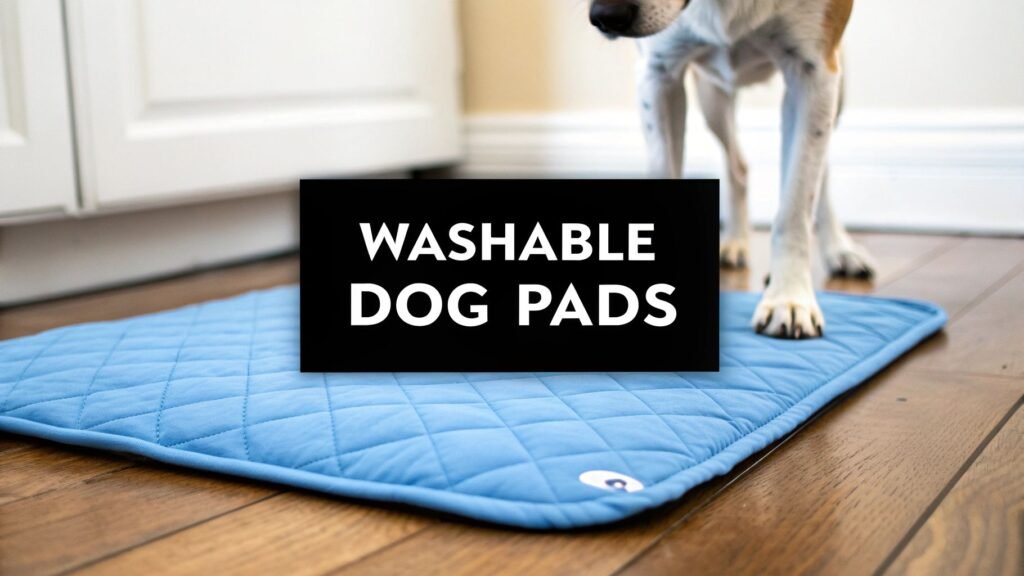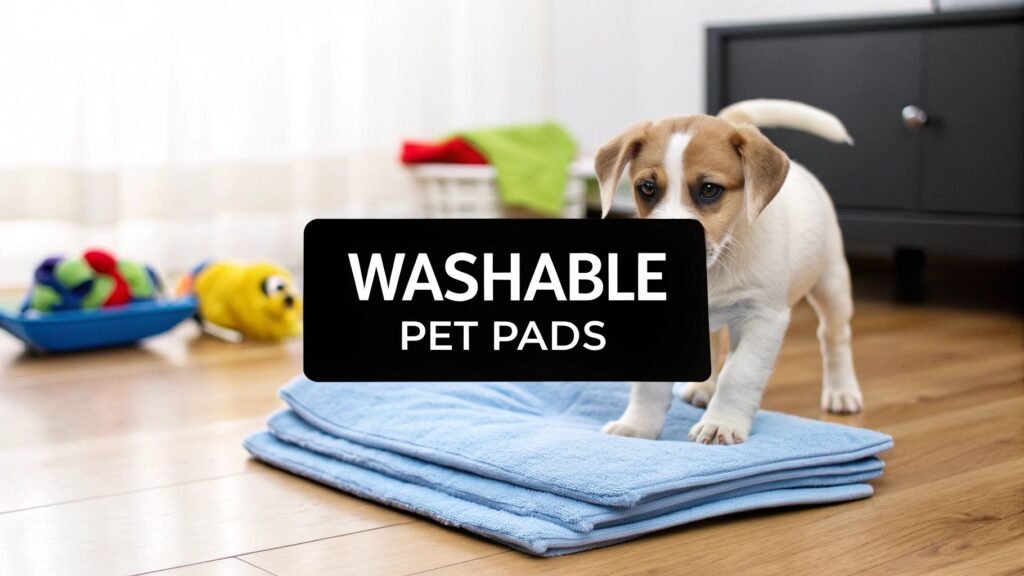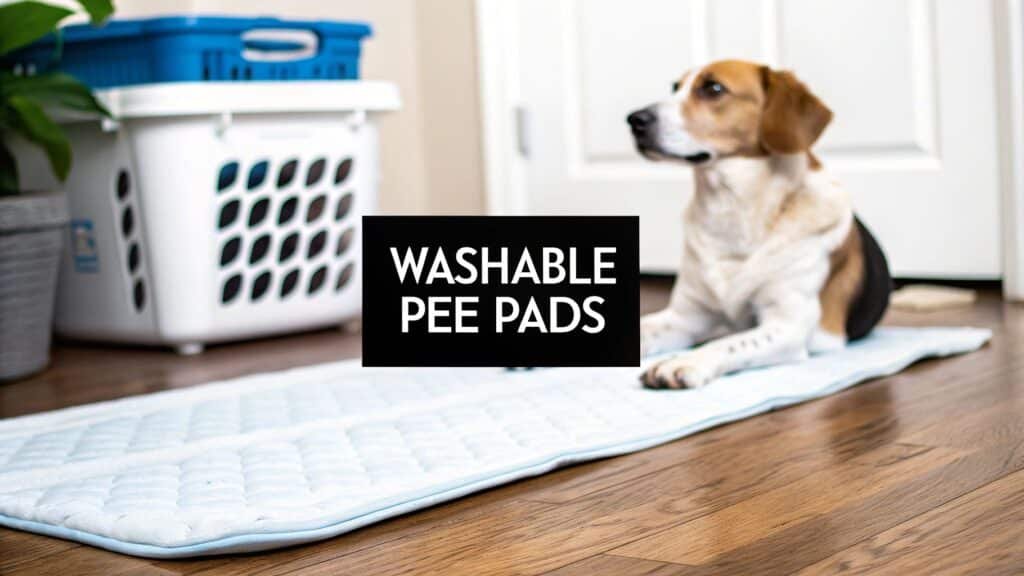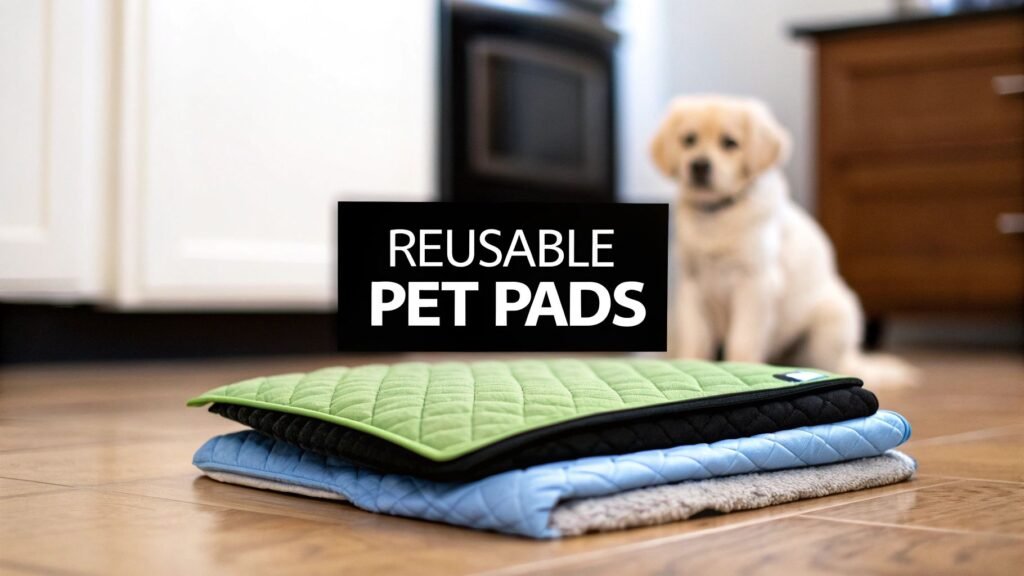A Modern Guide to Pee Pad Dog Training
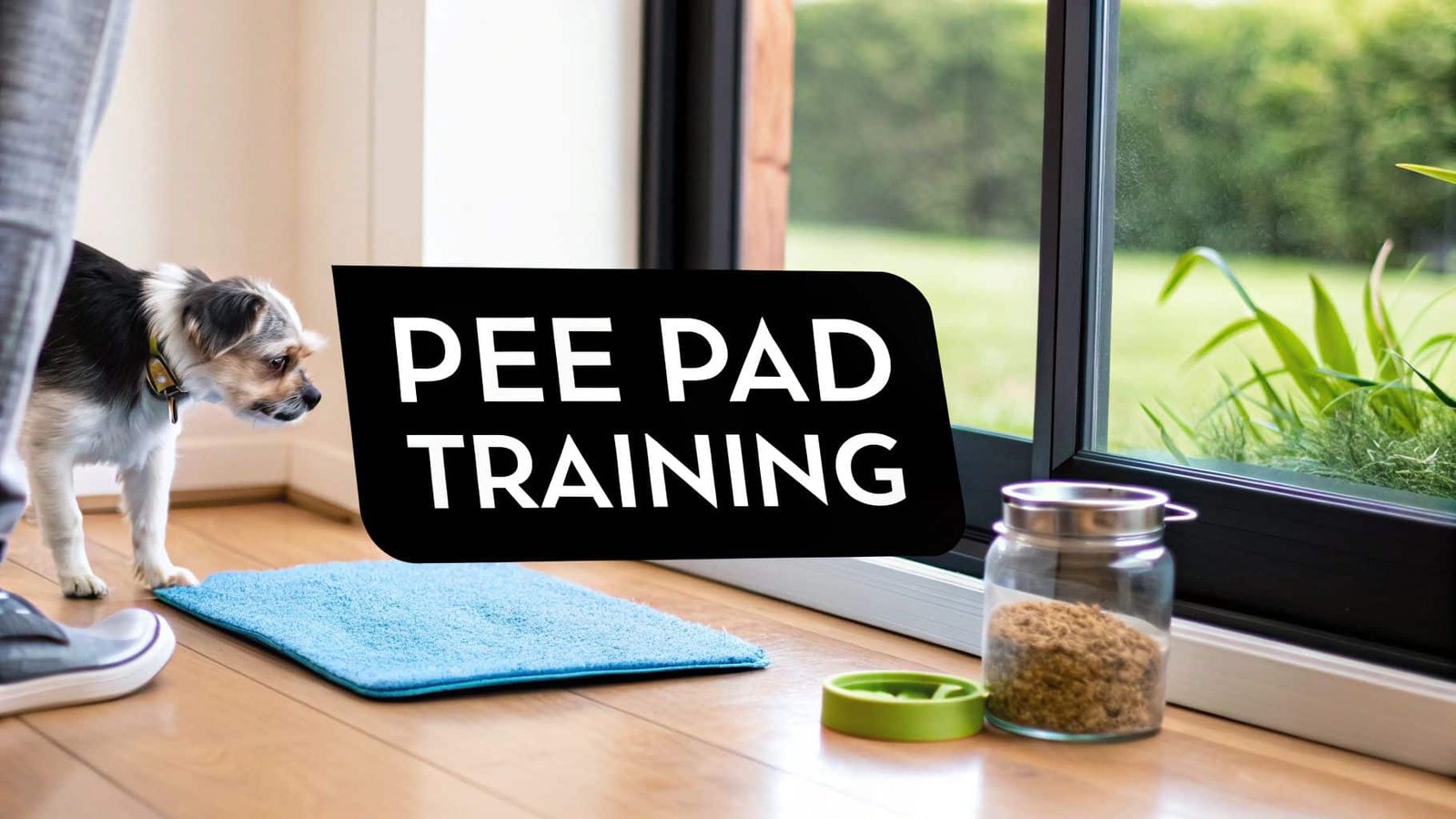
When you hear “pee pad,” you probably picture a new puppy. But a pee pad for a dog is so much more than a temporary training tool. Think of it as a strategic part of managing your dog’s potty needs indoors. Today’s pads are impressively absorbent and great at locking away odors, making them a lifesaver for apartment dwellers, owners of senior dogs, or anyone stuck inside during a crazy storm.
Why Pee Pad Training Is a Smart Choice
Let’s be real—house training is often one of the most frustrating parts of having a dog. The classic “they must go outside” approach just doesn’t work for every person or every lifestyle. Pee pads offer a practical, less stressful alternative that keeps your home clean and your dog happy.
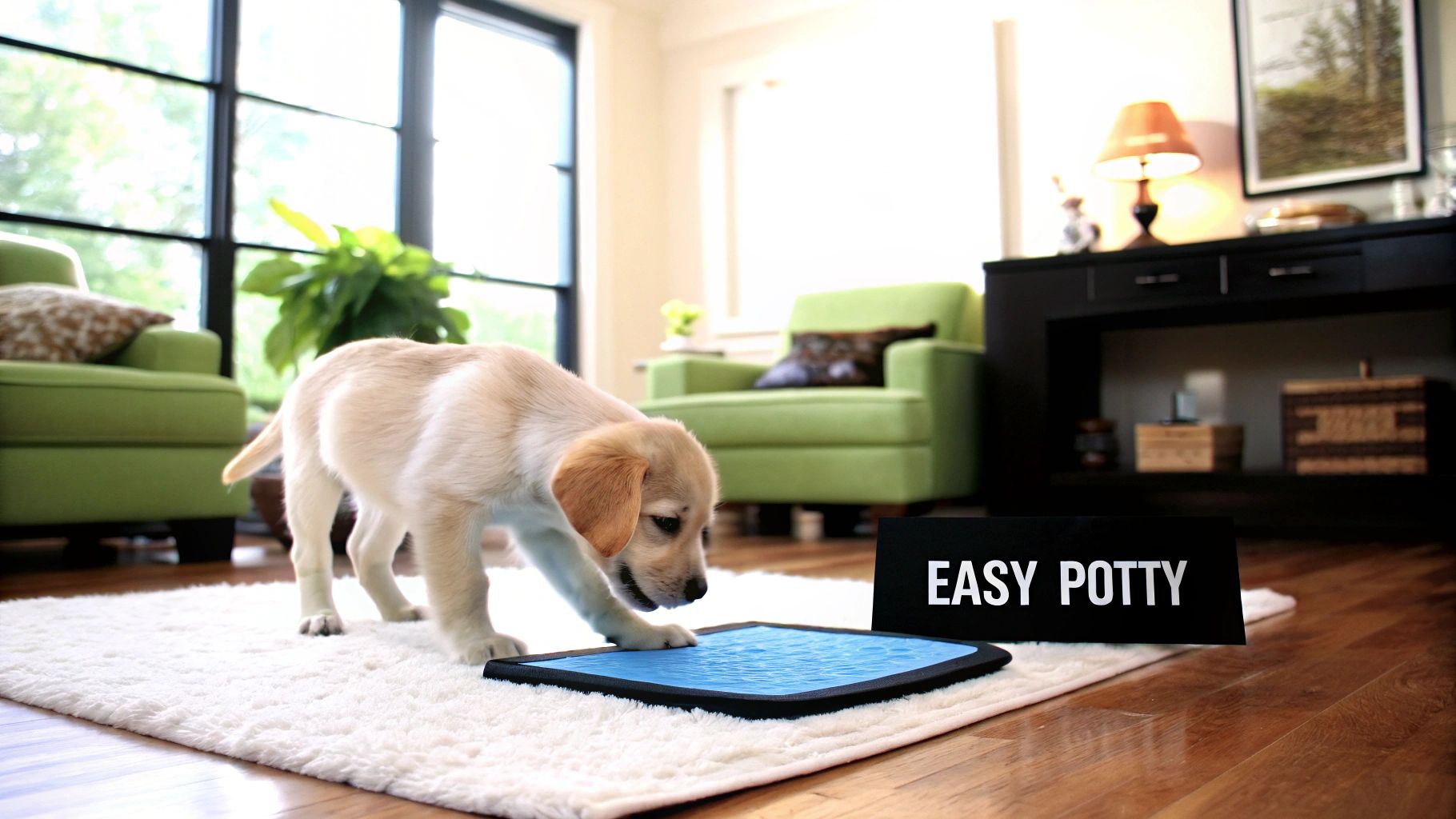
Beyond the Puppy Phase
While they are a game-changer for housebreaking puppies, the usefulness of a quality pee pad doesn’t end there. They provide a dependable indoor potty spot for all sorts of real-life situations.
- Apartment and High-Rise Living: If you’re in a city, taking your dog out for a midnight potty break isn’t always easy or safe. A designated pee pad spot gives you a secure and incredibly convenient option.
- Senior Dogs and Mobility Issues: As dogs age, they can struggle with incontinence or find stairs and long walks painful. Pee pads offer them a comfortable, easy-to-reach place to go, which helps maintain their dignity.
- Extreme Weather Conditions: From blizzards and hurricanes to blistering heatwaves, some weather just isn’t safe for a walk. A pee pad means your dog can relieve themselves safely inside, no matter what’s happening outdoors.
- Post-Surgery Recovery: A dog recovering from surgery or an injury often has limited mobility. An indoor potty option is essential for a smooth and comfortable healing process.
The Evolution of the Modern Pee Pad
Have you noticed how much better pee pads have gotten? That’s because we’ve started treating our pets more like family, and we’re willing to invest in better products for them. This push for quality has led to some serious innovation, like pads with incredible absorbency, activated charcoal for odor control, and even eco-friendly, reusable options.
This trend is especially strong in cities. As more people live in apartments and condos, the convenience of pee pads becomes undeniable. In fact, North America holds over 40% of the global market share, and a whopping 65% of urban pet-owning households rely on training pads. You can discover more insights about the growing pet pad market and its trends.
A pee pad isn’t a sign of training failure; it’s a tool for success. It adapts to your dog’s changing needs throughout their life, from the playful puppy stage to their graceful senior years, providing a consistent and stress-free solution.
At the end of the day, using a pee pad is about finding a system that fits your life and your dog’s needs. It’s a choice based on practicality, cleanliness, and making sure your best friend is always comfortable and cared for.
How to Choose the Right Pee Pad for Your Dog
Walking down the pet store aisle, it’s easy to feel overwhelmed by the sheer number of pee pad options. It’s not as simple as grabbing the first pack you see. The best choice really boils down to your dog’s specific needs and your lifestyle. A tiny Chihuahua has different requirements than a Great Dane, and a brand-new puppy’s needs are a world apart from a senior dog’s.
Getting this right from the start means fewer messes, a more comfortable dog, and a product that actually fits into your daily routine. Let’s dig into what you should be looking for.
Matching Pad Size to Your Dog
One of the most common missteps I see owners make is picking a pad that’s just too small. A bigger dog needs a bigger target—it’s that simple. If the pad is too small, you’ll constantly be cleaning up accidental misses right on the edge. You also have to consider your dog’s “potty dance.” Some pups circle and sniff around quite a bit before they finally go.
Here’s a quick-and-dirty guide:
- Small Breeds (under 20 lbs): A standard 22×22 inch pad is usually a safe bet.
- Medium Breeds (20-50 lbs): You’ll want something larger, like a 28×34 inch pad, to give them plenty of room.
- Large Breeds (over 50 lbs): Go big. Extra-large or giant pads (36×36 inches or more) are essential to handle the volume and prevent any overflow.
If you’re not sure how big your puppy will get, always err on the side of caution and go bigger. A larger target area makes success much more likely during those crucial early training days.
Absorbency and Odor Control Technologies
This is where you can really see the difference between a cheap pad and a quality one. Absorbency is everything; a pad that leaks is completely pointless. The best pads use a multi-layer design with a super-absorbent polymer core. This technology is pretty neat—it instantly turns liquid into a gel, locking moisture deep inside the pad.
Odor control is the other half of the equation. Basic pads might use a sprinkle of baking soda, but the more effective ones are infused with activated charcoal. This stuff is a powerhouse at trapping smells. Instead of just masking odors with a perfume, the charcoal’s porous structure actually captures and neutralizes the molecules causing the smell. This is a lifesaver in apartments or smaller living spaces where odors can quickly take over.
A high-quality pee pad isn’t just a piece of absorbent paper; it’s a multi-layered system designed for maximum liquid retention and odor neutralization. Investing in better technology means less cleanup and a fresher home.
Disposable vs. Washable: A Lifestyle Choice
This decision really comes down to what you value more: grab-and-go convenience or long-term savings and sustainability.
Disposable pads are incredibly easy. Use it, toss it, and lay down a fresh one. They’re perfect for travel, for people with hectic schedules, or for anyone who just doesn’t want to deal with soiled laundry.
On the flip side, washable pads are a fantastic eco-friendly and budget-friendly option in the long run. They’re gaining a lot of traction, too. The global market for washable pet pee pads was valued at around $245 million in 2023 and is expected to keep growing as more owners look for sustainable pet products. For a deeper dive, check out our guide on reusable dog pee pads vs. disposable.
To make the choice clearer, here’s a quick comparison of the most common types of pee pads on the market.
Comparing Pee Pad Types for Your Dog
| Feature | Standard Disposable Pads | Charcoal-Infused Pads | Washable/Reusable Pads | Biodegradable Pads |
|---|---|---|---|---|
| Absorbency | Moderate; can leak if oversaturated. | High; polymer core and charcoal offer superior lock-in. | Excellent; multiple fabric layers absorb and contain. | Moderate; similar to standard but with plant-based materials. |
| Odor Control | Basic, often uses baking soda or light fragrance. | Excellent; activated charcoal neutralizes odors. | Good; requires frequent washing to prevent smells. | Fair; natural materials may offer some odor resistance. |
| Convenience | Highest; simply toss after use. | High; toss after use, but excellent performance. | Lower; requires regular machine washing and drying. | High; toss after use, but with less environmental guilt. |
| Cost (Long-Term) | High; constant repurchasing adds up. | High; premium feature comes at a premium price. | Low; higher upfront cost but saves money over time. | Highest; eco-friendly materials are more expensive. |
| Environmental Impact | Poor; contributes significantly to landfill waste. | Poor; same landfill issues as standard pads. | Excellent; reduces waste and consumption. | Good; breaks down faster than traditional plastic pads. |
Ultimately, the right choice depends on balancing your budget, your desire for convenience, and your environmental concerns.
This infographic helps visualize some of those key differences.
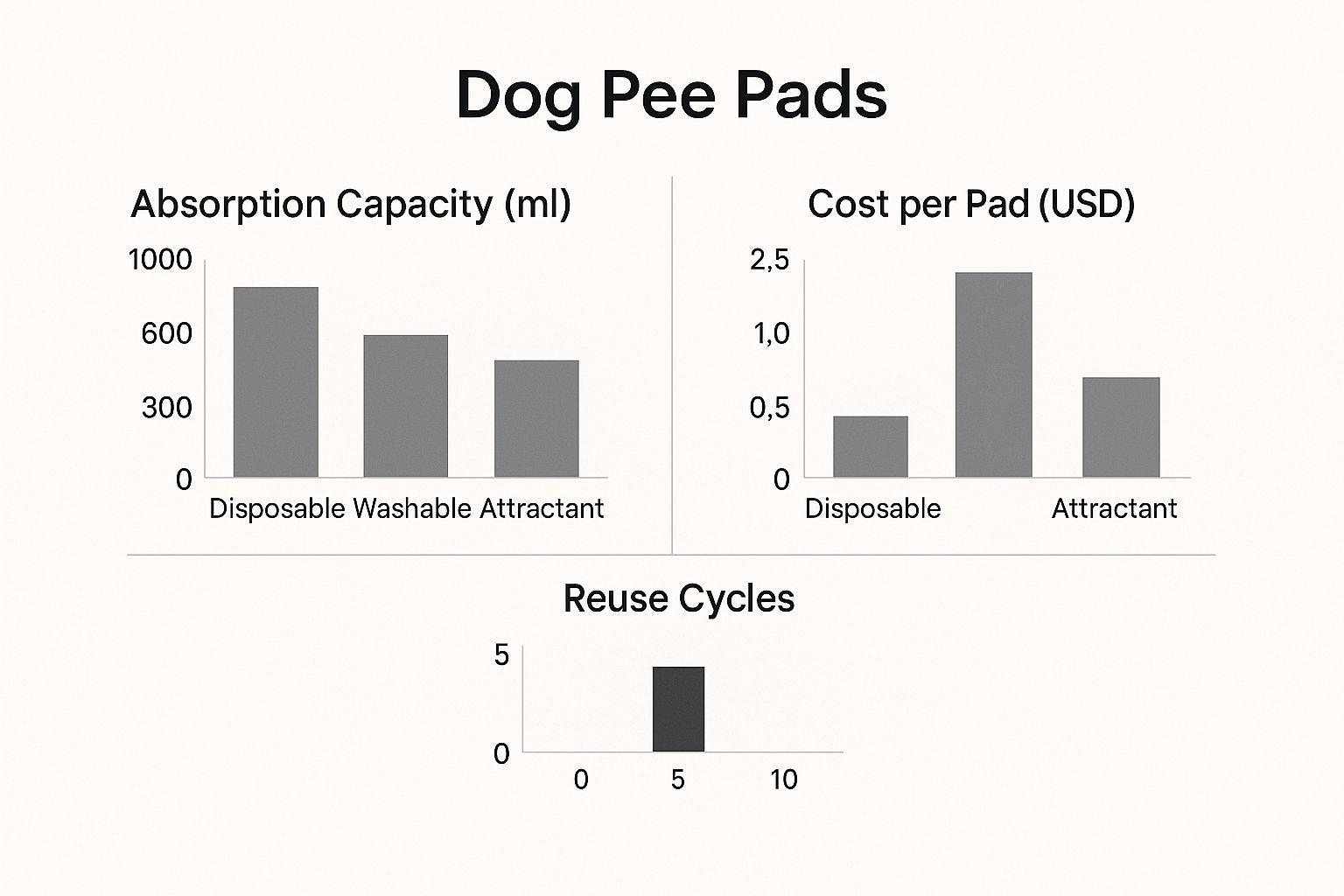
As you can see, while washable pads cost more initially, their reusability makes them the most economical option over your dog’s lifetime, and they often outperform disposables in the absorbency department.
Special Features to Look For
Beyond the core functions, some pads have extra bells and whistles that can make your life so much easier.
- Built-in Attractant: A lot of disposable pads are treated with a special scent (like pheromones or ammonia) that instinctively encourages your dog to go there. This can be a huge help when you’re first starting out with potty training.
- Non-Slip Backing: If you have hardwood or tile floors, look for a pad with a waterproof plastic backing that has some grip. This stops it from sliding all over the place the second your dog steps on it.
- Adhesive Strips: This is a game-changer. Some pads come with sticky tabs on the corners to hold them firmly in place. It’s a must-have if you have a playful pup who thinks a pee pad is a fun new toy to shred or drag across the room.
A Practical Guide to Pee Pad Training
So, you’ve picked out the perfect pee pad. Now for the real part—teaching your dog to use it. Don’t worry, successful training isn’t about being a drill sergeant. It’s all about clear communication, consistency, and a healthy dose of patience. Let’s walk through how to create a positive routine that turns that pee pad for a dog into their go-to potty spot.
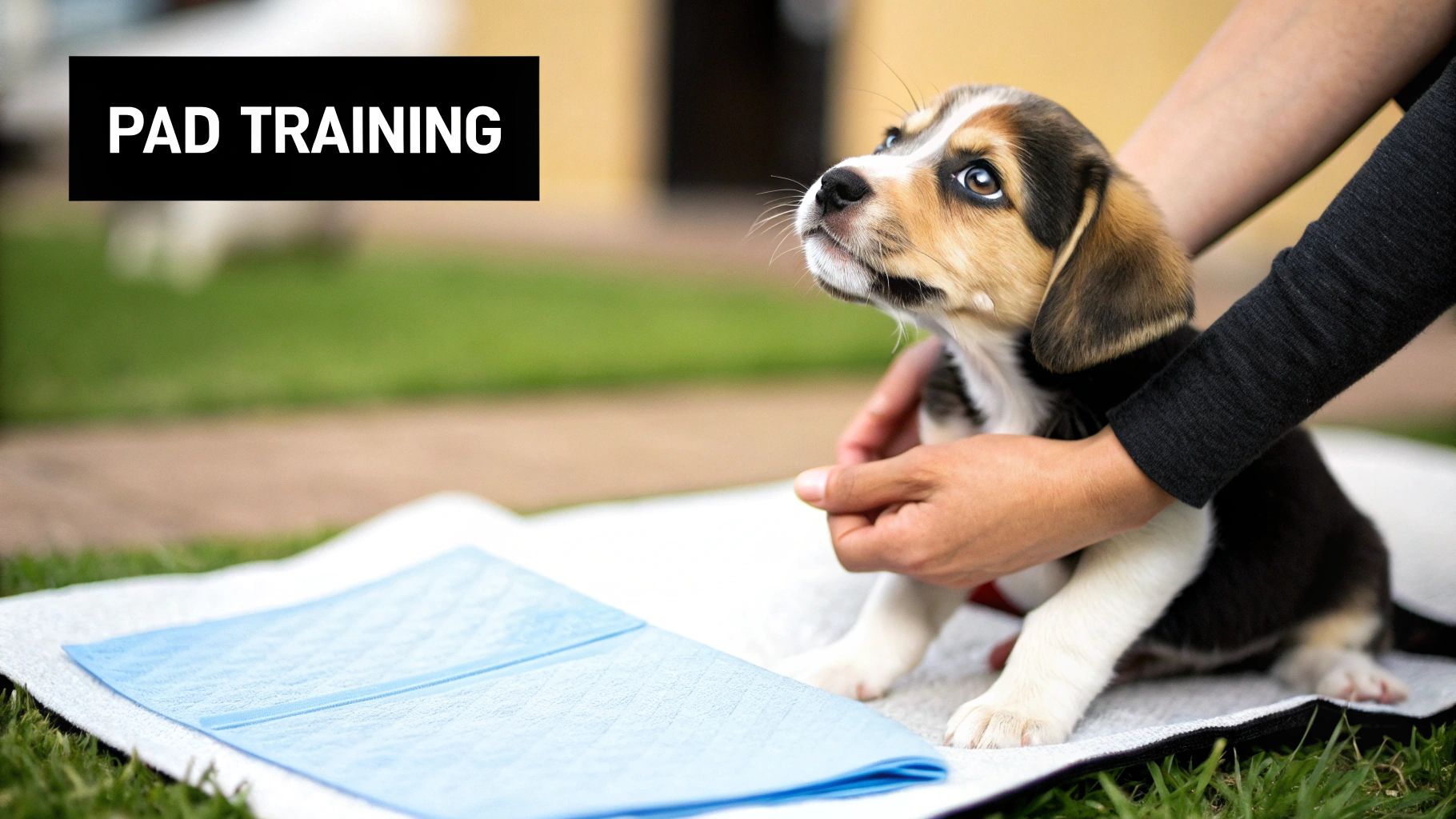
It’s a journey many pet owners are on. The puppy potty pad market is actually a pretty big deal, valued at $0.95 billion in 2024 and projected to hit $1.47 billion by 2033. This growth is largely thanks to the boom in pet adoptions. These pads aren’t just for puppy training or helping senior dogs; they also play a role in keeping homes more hygienic, which is a big win for everyone. You can dig deeper into the puppy potty pad market growth and trends if you’re curious.
Choosing the Perfect Location
First things first, where you put the pee pad can make or break your training. The ideal spot is easy for your dog to get to but also a little out of the way.
Try to see your home from your dog’s perspective. A quiet corner in the living room or a designated spot in the laundry room are often good choices. Just steer clear of busy hallways or the middle of the kitchen, where they might feel too exposed or get interrupted.
A great pee pad spot has a few things in common:
- Consistent: Once you pick a location, commit to it. Moving the pad around is a surefire way to confuse your dog and slow down progress.
- Accessible: Your pup, especially a little one with a tiny bladder, needs a clear, quick path to the pad. No obstacle courses!
- Low-Traffic: Give them a bit of privacy. Most dogs prefer to do their business without an audience.
- Away from Food and Water: It’s a natural instinct for dogs not to soil where they eat and sleep. Keep a good distance between the potty area and their bed and bowls.
Making a Positive Introduction
Alright, it’s time for the meet-and-greet. Your main goal here is to make your dog think this new pad is the best thing ever. Let them sniff and explore it without any pressure.
Gently place them on the pad while using a happy, encouraging voice. This isn’t the time for commands; you’re just showing them this new thing is safe and good.
Positive reinforcement is your superpower. Every time your dog uses the pad correctly, even if it’s just a little bit, celebrate it like they just won the lottery.
The moment they go, shower them with praise, offer a super tasty treat, and give them lots of pets. This immediate reward is what clicks in their brain and teaches them, “Oh, this is what you want me to do here!”
Mastering Cues and Timing
To really streamline the process, you need to get good at anticipating your dog’s needs and using a consistent cue. Puppies, in particular, run on a pretty predictable schedule.
Make it a habit to take your dog to the pee pad during these key moments:
- First thing in the morning and right after every nap.
- About 15-20 minutes after they eat a meal.
- Immediately after a good play session.
- One last time right before bed.
Whenever you lead them to the pad, use a simple, consistent verbal cue like “Go potty” or “Potty time.” Say it in a calm, upbeat tone. Before you know it, they’ll connect the phrase with the action.
Handling Accidents with Patience
Let’s be real: accidents will happen. They’re a completely normal part of learning. What truly matters is how you react. Never, ever punish your dog, scold them, or rub their nose in it. That will only teach them to be afraid of you, making house training a much bigger struggle.
If you catch them in the middle of an accident, make a short, surprising sound—like a clap—to interrupt them. Then, quickly and calmly scoop them up and place them on the pee pad, encouraging them to finish there. If they do, it’s time for another celebration!
If you discover the accident later, just clean it up without making a big deal. The key is to use an enzymatic cleaner made for pet messes. Standard cleaners won’t break down the odor molecules that essentially leave a sign for your dog saying, “This is a bathroom spot!” For a durable option that’s easy to clean again and again, something like our reusable dog pee pad blanket can be a real game-changer during the training phase.
Solving Common Pee Pad Training Problems
Let’s be real—even the most dedicated puppy parent hits a few snags with potty training. It happens to everyone! The trick is to not get discouraged. Instead, let’s figure out why your dog is struggling and get things back on track.
Before you jump to blaming your dog’s stubbornness, take a quick look at your gear. Sometimes, the problem is just a mismatch. A pad that’s too small or flimsy can lead to leaks and misses that have nothing to do with training. Make sure the pad itself is actually up to the job.
“My Dog Keeps Missing the Pad”
This is probably the most common complaint I hear. Your dog gets the general idea—they’re right next to the pad—but their aim is just a little off. This usually comes down to one of two simple things.
First, check the pad size. A tiny pad is a tiny target. For a dog that likes to circle a bit before doing their business, it’s really easy to misjudge. Just switching to a larger pad can give them the buffer they need and solve the problem almost instantly.
Another great trick is to use a potty pad attractant spray. These sprays use pheromone-like scents that essentially tell your dog, “This is the spot!” A couple of spritzes on the center of a clean pad can make the target much more appealing and guide them right where they need to be.
“They Treat the Pad Like a Toy”
Does your training area look like a confetti party? You’re not alone. Puppies, especially when they’re teething, often see a crinkly, soft pad as the world’s best chew toy. This is more than just a mess; it can be dangerous if they swallow pieces of the plastic liner or the absorbent material inside.
Here’s how you can shut down the shred-fest:
- Get a Pee Pad Holder: Think of it as a picture frame for your pee pad. These plastic trays snap over the edges, keeping the pad flat and secure. If your pup can’t get a corner up, they can’t start shredding.
- Use Pads with Adhesive Strips: Many premium pads come with built-in sticky tabs. Peeling these off and sticking the pad to the floor makes it much harder for your dog to bunch it up or drag it across the room.
- Switch to a Washable Pad: Heavy-duty, fabric-based pads are just not as fun to tear apart. They don’t have that satisfying crinkle, and their durable construction makes them a much less interesting target for a determined chewer.
“They Suddenly Stopped Using It”
When a dog who was doing great suddenly starts having accidents everywhere, it’s a huge red flag. This isn’t your dog being defiant; it’s often their only way of telling you something is wrong.
Your first move should always be to call your veterinarian. A sudden change in potty habits is a classic sign of a urinary tract infection (UTI), bladder stones, or other medical problems. You need to rule out a health issue before you even think about re-training.
If the vet gives your dog a clean bill of health, it’s time to play detective at home.
A sudden regression in potty training is often linked to stress or environmental changes. Have you moved furniture? Has your work schedule changed? Is there a new person or pet in the house? Dogs thrive on routine, and disruptions can cause anxiety that manifests as potty accidents.
Go back to basics. Dust off the positive reinforcement and act like it’s day one again. Reward them with lots of praise and a high-value treat every single time they use the pee pad dog spot correctly. Sometimes, all they need is a little refresher course to rebuild their confidence.
“My Dog Goes Next to the Pad, But Not On It”
This one is uniquely maddening. They’re so close! This almost always happens because the pad is no longer perfectly clean. Many dogs are quite picky and will refuse to step on a spot they’ve already used, even if it was just once.
The fix? Be incredibly diligent. Change the disposable pad after every single use. If you’re using washable pads, make sure you have a few in rotation so you can swap in a fresh one immediately.
For stubborn cases, a good enzymatic cleaner is essential. Use it to scrub the floor around the pad to completely break down any lingering scent molecules. If the floor smells faintly like a bathroom spot, it can confuse your dog into thinking “close enough is good enough.” Keeping the entire area pristine makes the clean pad the only right answer.
Keeping Your Home Clean and Odor-Free
Let’s be honest, the whole point of using a pee pad for a dog is to make life easier, not to trade one mess for another—like a lingering odor. The secret to keeping your home smelling fresh isn’t some magic trick; it’s all about a simple, consistent routine. If you get ahead of the smells, you’ll never have to worry about them.
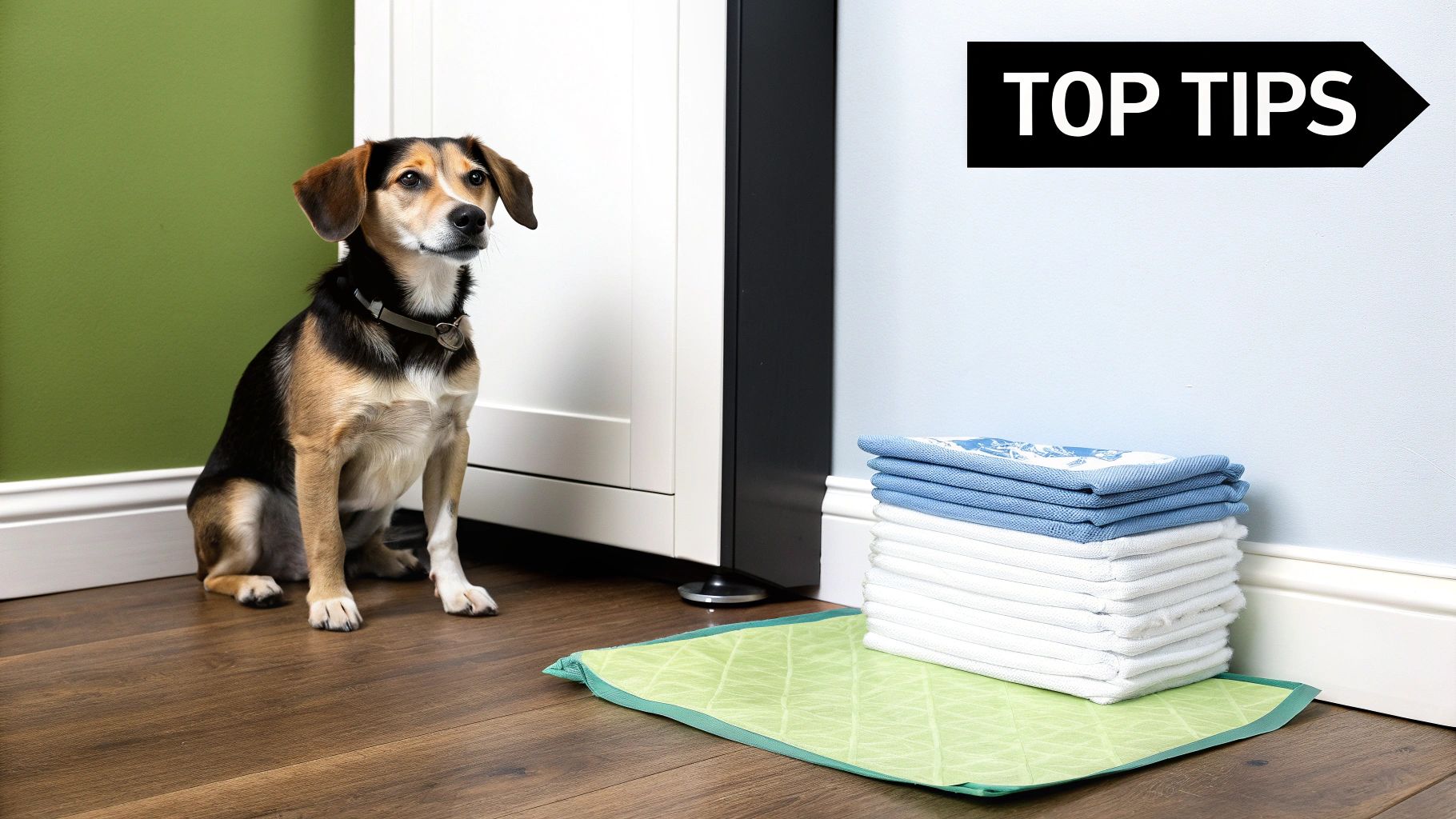
This little bit of maintenance does more than just keep your house pleasant. It also encourages your dog to keep using the right spot, making the whole system work for everyone.
Managing Disposable Pee Pads
When you’re using disposable pads, the number one rule is to change them frequently. I can’t stress this enough. Don’t wait for the pad to look like a water-logged sponge. A good rule of thumb is to swap it out after one or two uses, especially if you have a larger dog.
A soiled pad that sits for too long is a guaranteed recipe for odor. Even with a plastic backing, moisture can eventually seep through and damage your floors. Get into a rhythm: change it first thing in the morning, right before bed, and any time you see it’s been used during the day.
Laundering Washable Dog Pee Pads
If you’ve gone the reusable route—which is great for the environment and your wallet—your routine is about washing, not tossing. To really knock out those odors, you need to clean them correctly.
Here’s a process that actually works:
- Quick Pre-Rinse: Before it goes in the wash, give the pad a quick rinse with cool water if you can. This gets rid of the worst of it and lets the detergent do its job on a deeper level.
- Go for an Enzymatic Detergent: This is the game-changer. Standard detergents might make the pad smell nice temporarily, but an enzymatic cleaner has special enzymes that break down the uric acid in urine. It doesn’t just mask the smell; it eliminates it completely.
- Bring the Heat: Wash the pad on the hottest cycle the material can handle. The heat is fantastic for killing bacteria and breaking down any stubborn odor molecules.
- Add a Natural Deodorizer (Optional): Want an extra boost of freshness? Throw a cup of white vinegar or a scoop of baking soda into the wash. They’re both cheap, pet-safe, and incredibly effective at neutralizing odors.
- Air Dry or Tumble Low: Always check the tag, but air drying in the sun is a fantastic option. The sun’s UV rays are a natural sanitizer. If you have to use a dryer, stick to a low heat setting to avoid damaging the waterproof layer.
Pro Tip: Steer clear of fabric softeners and dryer sheets. They leave behind a film that can build up over time, which sounds nice but actually makes the pad less absorbent.
Keeping the Floor Beneath Pristine
No matter what kind of pad you’re using, don’t forget about the floor underneath. Even the best pads can have tiny leaks or a bit of “splash back.” You might not see it, but your dog can definitely smell it.
This is a common mistake I see people make. They grab their usual household cleaner, many of which contain ammonia. Since urine also contains ammonia, you’re basically sending your dog a signal that says, “This is a bathroom!”
The right way to do it is to wipe the area down with a pet-safe enzymatic spray every time you change the pad. This destroys any trace of urine protein, which stops your dog from wanting to re-mark the spot and ensures your home stays truly clean. For some great options, check out our collection of grooming and cleaning supplies made specifically for pet-loving homes.
Got Pee Pad Questions? We’ve Got Answers
Even with the best game plan, you’re going to have questions pop up during training. It’s totally normal. From juggling indoor and outdoor potty breaks to managing a multi-dog household, let’s walk through some of the most common challenges pet owners face.
Think of this as your quick-reference guide for all those “what if” moments. Getting these details sorted out will make the whole process feel less stressful and far more successful for both you and your dog.
Can I Really Teach My Dog to Use Both a Pee Pad and Go Outside?
Yes, you absolutely can! This is often called “dual training,” and it’s a fantastic option for owners who need a bit of flexibility. It gives your dog a reliable indoor spot for those times when you can’t get outside—think bad weather, a long workday, or the middle of the night—without messing up their outdoor potty routine.
The secret to making this work is to create very clear and distinct signals for each location. For example, when you lead your dog to the pee pad, use a specific verbal cue like, “Go Potty.” But when you head for the door to go outside, switch it up to something different, like “Outside Time.” This simple change helps your dog understand there are two approved, but different, places to go.
Just remember, consistency is your best friend here. Always guide them to the right spot at the usual times—first thing in the morning, after meals, before bed—and stick to your specific verbal cues.
Dual training isn’t about creating confusion; it’s about creating convenient options. It offers a practical safety net for indoor needs while keeping the all-important outdoor routine firmly in place.
How Do I Wean My Dog Off Pee Pads and Go Completely Outside?
Making the leap from pee pads to an exclusively outdoor routine is a major milestone, especially for puppies who are finally gaining reliable bladder control. The key is to take it slow and steady, not all at once.
- Inch It to the Door: Start by moving the pee pad closer to the exit you use for potty breaks. Don’t make a huge jump in one day; just slide it a few feet closer every day or two. This gradual shift keeps your dog from getting confused.
- Take the Pad With You: Once the pad is right next to the door, the next logical step is to place it just outside that door, right where you want them to do their business. They’ll recognize the pad as their target, just in a new location.
- Shrink the Target: After your dog has successfully used the pad outside a few times, you can start to make it smaller. Try folding it in half. Soon enough, you can remove it entirely.
- Celebrate Every Outdoor Win: This is the most important part. When they go potty outside (with or without the pad), make a huge deal out of it! Shower them with praise and offer a high-value treat. You want to reinforce that going outside is the best thing ever.
What If I Have More Than One Dog?
Using pee pads in a multi-dog household can feel like orchestrating a small circus, but it’s definitely manageable. The biggest hurdles are making sure every dog has a clean spot and preventing any territorial squabbles.
You’ll almost certainly need more than one potty station or a much larger pad. Some dogs are particular and refuse to use a spot another dog has already soiled. Setting up a couple of clean pads in different, quiet areas of your home can head off potential accidents.
Also, just be ready to change the pads way more often. A good rule of thumb is to watch each dog’s habits and clean up immediately after they go. This keeps the area fresh and inviting for the next dog who needs it.
At Ur Pet Store, we know that every dog and owner has a unique story. That’s why we stock a wide range of top-notch pet supplies to help you through every stage, from puppyhood to their golden years. Whether you need ultra-absorbent pads, tough toys, or grooming gear, you’ll find everything to build a happy, healthy home. Check out our collections and get free shipping on all orders at https://urpetstore.com.


